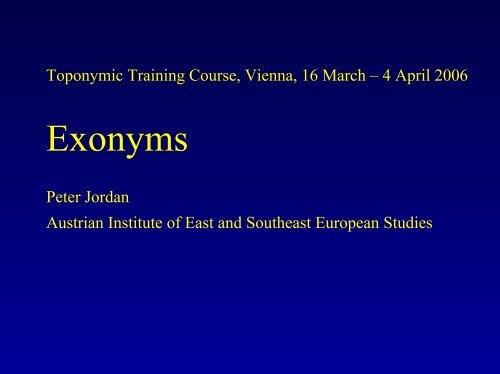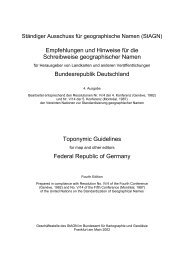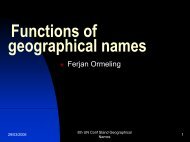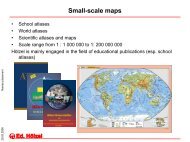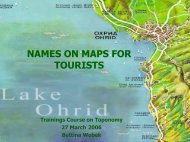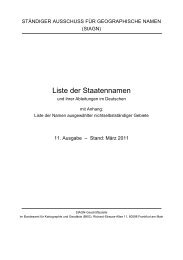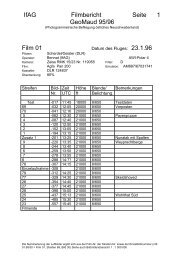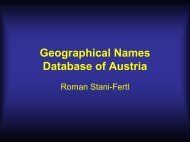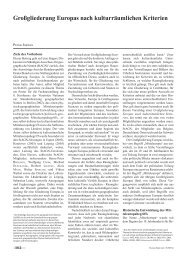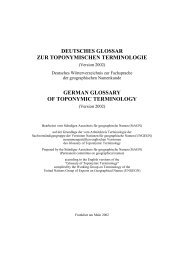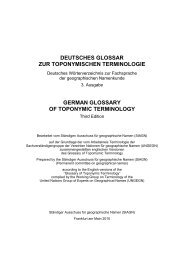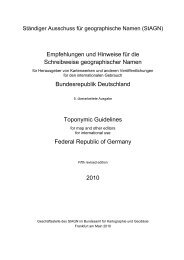Exonyms
Exonyms
Exonyms
Create successful ePaper yourself
Turn your PDF publications into a flip-book with our unique Google optimized e-Paper software.
Toponymic Training Course, Vienna, 16 March – 4 April 2006<br />
<strong>Exonyms</strong><br />
Peter Jordan<br />
Austrian Institute of East and Southeast European Studies
DEFINITIONS<br />
Exonym = conventional name = traditional name<br />
Endonym = internal denomination of a geographical feature<br />
Exonym = external denomination of a geographical feature<br />
Endonym = name in the language of the local population<br />
Exonym = name in another language
UNGEGN Glossary<br />
Endonym = Name of a geographical feature in one of the<br />
languages occurring in the area where the feature is situated<br />
Exonym = Name used in a specific language for a geographical<br />
feature situated outside the area where that language has official<br />
status, and differing in its form from the name used in the<br />
official language or languages of the area where the<br />
geographical feature is situated
Proposal UNGEGN WG on <strong>Exonyms</strong><br />
Endonym = Name of a geographical feature in an official or<br />
well-established language occurring in that area where the<br />
feature is located.<br />
Exonym = Name used in a specific language for a geographical<br />
feature situated outside the area where that language is spoken,<br />
and differing in its form from the name used in an official or<br />
well-established language of that area where the geographical<br />
feature is located..
EXAMPLES FROM PRACTICE.
S 1a: Geografski atlas Slovenije [Geographical Atlas of<br />
Slovenia], Ljubljana 1998<br />
S 1b: National Atlas of Slovenia, Ljubljana 2001<br />
C 1: A Concise Atlas of the Republic of Croatia & of the<br />
Republic of Bosnia and Hercegovina, Zagreb 1993<br />
C 2: Veliki atlas Hrvatske [Large Atlas of Croatia], Zagreb<br />
2002<br />
PL: Atlas Śląska dolnego i opolskiego [Atlas of Lower and<br />
Opole Silesia], Wrocław 1997<br />
RO: România. Atlas istorico-geografic [Romania. Historicalgeographical<br />
Atlas]. Bucureşti 1996
S 1a<br />
Geographical Atlas of Slovenia<br />
Ljubljana 1998<br />
monolingual Slovene
S 1a<br />
S. 14 Ausschnitt La Coruna mit rt Finisterre
S 1a<br />
S. 14 Ausschnitt Champagne
S 1a<br />
S. 14 Ausschnitt Tauern
S 1a<br />
S. 14 Ausschnitt Lissabon
S 1a<br />
S. 16 Ausschnitt Norditalien
S 1b<br />
National Atlas of Slovenia<br />
Ljubljana 2001<br />
monolingual English
S 1b<br />
S. 21 Ausschnitt Südkärnten (AUSTRIA noch<br />
drauf)
S 1b<br />
S. 185 Ausschnitt Glossary (rechts oben)
C 1<br />
A Concise Atlas of the Republic of Croatia<br />
&<br />
of the Republic of Bosnia and Hercegovina<br />
Zagreb 1993<br />
monolingual English
C 1<br />
S. 10 Ausschnitt Iberische Halbinsel
C 1<br />
S. 12 Ausschnitt Triest
C 2<br />
Large Atlas of Croatia<br />
Zagreb 2002<br />
monolingual Croatian
C 2<br />
Blattübersicht: Ausschnitt Udine, Görz, Triest
C 2<br />
S. 2: Ausschnitt Lendava
PL<br />
Atlas of Lower and Opole Silesia<br />
Wrocław 1997<br />
trilingual (Polish, English, German)
PL<br />
Aus einer gegenwartsbezogenen Karte, die auf<br />
Schlesien fokussiert ist einen kleinen Auslandsteil
PL<br />
S. 3: Ausschnitt Friesische Inseln
RO<br />
Historical-geographical atlas of Romania<br />
Bucureşti 1996<br />
quadrilingual (Romanian, French, English, German)
RO<br />
Tafel 2: Ausschnitt Deutschland, Österreich,<br />
Schweiz
METHODOLOGICAL REMARKS
Monolingual mapworks are to use<br />
-exonyms corresponding to the editorial language<br />
-exonyms always accompanied by endonyms<br />
Multilingual mapworks are to<br />
-avoid exonyms<br />
or<br />
-use exonyms of all editorial languages simultaneously
SOME<br />
METHODOLOGICAL<br />
CONSIDERATIONS<br />
IN GENERAL<br />
How to decide between endonym/exonym
Assumption:<br />
A widely used exonym exists
Endonym<br />
(1) Object-related criteria<br />
Exonym<br />
Low<br />
Importance of the object<br />
object<br />
High<br />
Inside a<br />
community<br />
Object extension related to to<br />
language communities<br />
communities<br />
Across<br />
community<br />
boundaries<br />
Culture<br />
object<br />
Culture-dependency<br />
of the object<br />
Nature<br />
object<br />
Distant<br />
Spatial distance object-receiver community<br />
Close<br />
Currently<br />
existing<br />
Time-layer<br />
of the object<br />
Historical<br />
Bold = Exonym use partly imperative
Not<br />
including a<br />
generic<br />
term<br />
Endonym<br />
(2) Endonym (word)-related criteria<br />
Composition Importance of of the the endonym<br />
object<br />
Exonym<br />
Including a<br />
generic term<br />
Endonym<br />
in script<br />
of the<br />
receiver<br />
community<br />
Object extension related to language communities<br />
Script<br />
Endonym<br />
in another<br />
script
(3) Criteria referring to the relation endonymreceiver<br />
community<br />
Endonym<br />
Exonym<br />
Close<br />
Linguistic relation Importance endonym-receiver of the object<br />
language<br />
Distant<br />
Low<br />
Object Difficulty extension of related spelling to and language pronunciation<br />
communities<br />
High<br />
Distant<br />
Cultural (other than linguistic) relation<br />
Endonym-receiver community<br />
Close<br />
High<br />
Prestige, communication value<br />
of the endonym language<br />
Low
Endonym<br />
(4) Medium-related criteria<br />
Exonym<br />
Cartographic<br />
Means Importance of communication<br />
of the object<br />
Oral<br />
Inside the<br />
endonym<br />
region<br />
Object extension related to language communities<br />
Practical use of the medium<br />
Outside the<br />
endonym<br />
region
Endonym<br />
(5) Criteria related to the level of communication<br />
Exonym<br />
Official<br />
Officiality Importance of communication<br />
of the object<br />
Inofficial<br />
Asking,<br />
polite<br />
Object extension related to language communities<br />
Intention, atmosphere of communication<br />
From a<br />
position<br />
of strength
Endonym<br />
(6) Audience-related criteria<br />
Exonym<br />
Multilingual<br />
Linguistic Importance scope of of the the object<br />
audience<br />
Monolingual<br />
Bold = Edonym use imperative
BENEFITS<br />
OF<br />
USING EXONYMS
<strong>Exonyms</strong> can be pronounced according to the rules of the own<br />
language.<br />
From exonyms grammatical derivations according to the own<br />
grammar can be formed.<br />
<strong>Exonyms</strong> are more stable.<br />
<strong>Exonyms</strong> are anyway needed in historical and ethnographic<br />
contexts.
<strong>Exonyms</strong> indicate the importance of geographical objects and<br />
traditional relations in trade, politics and culture.<br />
<strong>Exonyms</strong> relate geographical objects outside a language<br />
community to objects within.<br />
<strong>Exonyms</strong> frequently replace official names that are in fact<br />
rarely used at the spot.
DANGERS<br />
OF<br />
USING EXONYMS
Outlining historical borders or historical ethnic situations<br />
Perpetuating political constructs<br />
Use in a politically and culturally offensive or aggressive way<br />
Re-animation of historical names which are not in current use<br />
with a wider stratum of educated people
….since exonyms are a politically sensitive<br />
matter!!!!<br />
(They may be regarded as an instrument of<br />
cultural imperialism.)
RECOMMENDATIONS<br />
OF THE<br />
UNITED NATIONS<br />
or<br />
How to be on the safe side
Resolution IV/20<br />
The Conference<br />
Noting that, in accordance with resolutions 18 and 19 of the Third United<br />
Nations Conference on the Standardization of Geographical Names, further<br />
progress has been made in the reduction of the number of exonyms used and<br />
a number of States have prepared lists of their own exonyms,<br />
Realizing that the reduction of exonyms used has not been carried out with<br />
the same intensity by all States,<br />
Realizing further that the methods and principles aimed at a reduction of the<br />
number of exonyms used should constantly be reviewed for expeditious<br />
implementation of the resolutions and understanding that not all countries<br />
can govern the content of maps and atlases published within their countries,<br />
Recommends that exonyms giving rise to international problems should be<br />
used very sparingly and published in parenthesis within the nationally<br />
accepted standard name.
Thank you!


